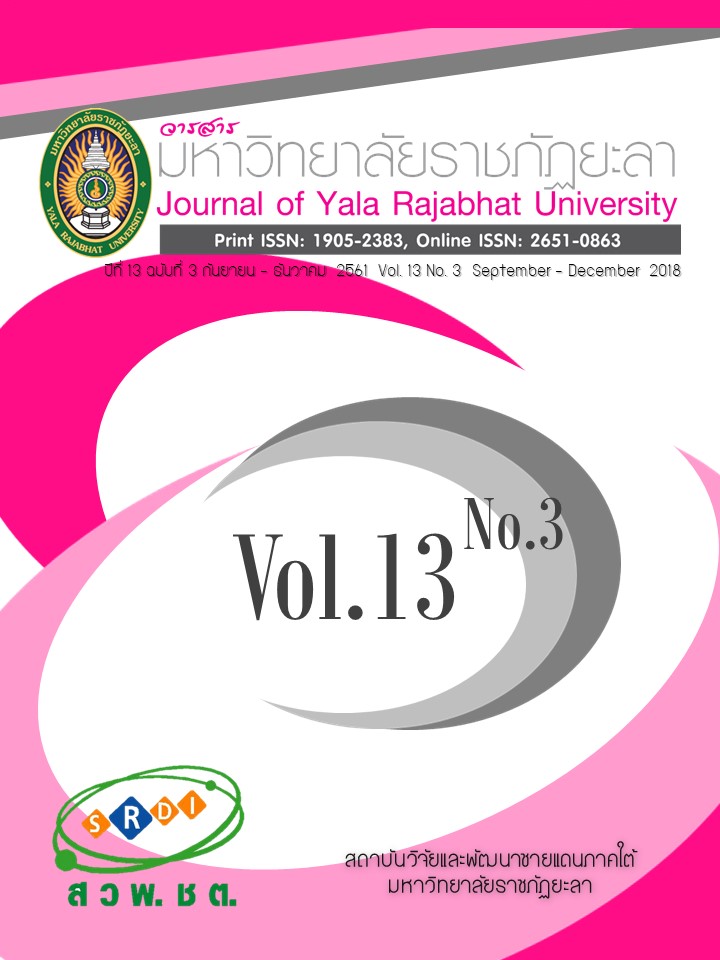การพัฒนาตัวชี้วัดความอยู่ดีมีสุขของชุมชนชนบทในภาคตะวันออกเฉียงเหนือของประเทศไทย : กรณีศึกษาชุมชนชนบทในจังหวัดขอนแก่น
Main Article Content
บทคัดย่อ
การวัดความอยู่ดีมีสุขที่ผ่านมามุ่งวัดที่ปัจเจก แต่การวัดความอยู่ดีมีสุขของชุมชนยังคงต้องได้รับการพัฒนา บทความนี้มีวัตถุประสงค์เพื่อศึกษาความหมายและพัฒนาตัวชี้วัดความอยู่ดีมีสุขของชุมชนชนบทในภาคตะวันออกเฉียงเหนือของประเทศไทย กรณีศึกษาจังหวัดขอนแก่น โดยใช้ระเบียบวิธีวิจัยเชิงคุณภาพและการทบทวนวรรณกรรมที่เกี่ยวข้อง มีวิธีการเก็บข้อมูลคือ การสนทนากลุ่มผู้นำ 6 กลุ่ม จำนวน 35 คน และการสัมภาษณ์เชิงลึกกับคนในชุมชน 30 คน โดยคัดเลือกมาจาก 3 ชุมชน และใช้การวิเคราะห์เนื้อหา ผลการศึกษาพบว่า ความหมายของความอยู่ดีมีสุขมีหลายมิติ ได้แก่ เศรษฐกิจ สังคม สิ่งแวดล้อม และสุขภาพ และให้ความสำคัญกับความสัมพันธ์ของคนในชุมชน และพบว่าตัวชี้วัดความอยู่ดีมีสุขของชุมชนชนบทมี 4 หมวด ได้แก่ 1) ความอยู่ดีมีสุขของชุมชนทางด้านวัตถุ 2) ความไว้วางใจของชุมชน 3) ความมั่นคงปลอดภัยของชุมชน และ 4) ความเข้มแข็งของชุมชน และ 35 ตัวชี้วัด
Article Details
บทความ ข้อมูล เนื้อหา รูปภาพ ฯลฯ ที่ได้รับการเผยแพร่ในวารสารมหาวิทยาลัยราชภัฏยะลานี้ ถือเป็นลิขสิทธิ์ของวารสารมหาวิทยาลัยราชภัฏยะลา หากบุคคลหรือหน่วยงานใดต้องการนำทั้งหมดหรือส่วนหนึ่งส่วนใดไปเผยแพร่ต่อหรือกระทำการใดๆ จะต้องได้รับอนุญาตเป็นลายลักษณ์อักษรจากวารสารมหาวิทยาลัยราชภัฏยะลาก่อนเท่านั้น
เอกสารอ้างอิง
2. Beck, W., Van der Maesen, L. & Walker, A. (2001). Chapter 17 Theorizing social quality: the concept’s validity. In
3. Beck, W., Van der Maesen, L., Thomése, F. & Walker, A. (Eds.). Social Quality: A Vision for Europe. (pp. 307-360). The Hague, The Netherlands: Kluwer Law International.
4.Cox, D., Frere, M., West, S. & Wiseman, J. (2010). Developing and using local community Wellbeing indicators: Learning from the experience of Community Indicators Victoria. The Australian Journal of Social Issues, 45(1), 71.
5. Devine, J., Camfield, L. & Gough, I. (2008). Autonomy or dependence–or both?: perspectives from Bangladesh. Journal of Happiness Studies, 9(1), 105-138.
6. Kim, Y. & Lee, S. J. (2014). The development and application of a community wellbeing index in Korean metropolitan cities. Social Indicators Research, 119(2), 533-558.
7. Lee, S. J. & Kim, Y. (2015). Searching for the meaning of community well-being. In Community Well-Being and Community Development (pp. 9-23). Switzerland: Springer International Publishing.
8. Mahatnirunkul, S., Tantipiwattanakul, W. & Pumpaisalchai, W. (2002). World Health Organization Quality of Life Brief-Thai (WHOQOL-BREF-THAI). Chiangmai: Project of the Development of Program Package for Psychology Survey in the Target Area in 2002. (in Thai)
9. Manolom, T. & Promphakping, B. (2015). Measuring well-being from local perspective: The case of Lao PDR. Social Indicators Research, 123(2), 391-409.
10. McGregor, J. A., Camfield, L., Masae, A. & Promphaking, B. (2008). Wellbeing, development and social change in Thailand. Thammasat Economic Journal, 26(2), 1-27.
11. Murphy, B. L. (2010). Community Well-Being: An Overview of the Concept. Canada: Nuclear water management organization.
12. NESDB. (2001). The Analysis of Economic, Social and Cultural Factors to Support Strengthening Community. Bangkok: NESDB office. (in Thai)
13. NESDB. (2013). Poverty in National and Regional Level. Bangkok: NESDB office. (in Thai)
14. NSO. (2010). The Survey of Agricultural Changing in 2008. Bangkok: NSO office. (in Thai)
15. Promphakping, B., Nakham, M., Klangsang, K., Sriprom, P., Pankham, P., Prukrathok, N., et al. (2009). The Development of Local Administration Organisation and Community Organisation for Developing and Utilizing the Social Capitals in Decreasing Poverty Phase II (Final Report). Khon Kaen: WeSD. (in Thai)
16. Putsyainunt, B., Yongvanit, S. & Kunurat, P. (2016). The Change in Economy and Social Livelihood in the Contract Farming System: Case Study Pong Hang Village Moo5 Vang Hin Lad Sub District, Chumpae District, Khon Kaen Province. Journal of Yala Rajabhat University, 11(1), 121-141. (in Thai)
17. Siribanpitak, P. & Kijtorntham, W. (2009). Interdisciplinarity of Quality of Community Life. Journal of The National Research Council of Thailand: Social Science, 41(1), 133-143. (in Thai)
18. Stiglitz, J. E., Sen, A. & Fitoussi, J. P. (2010). Report by the commission on the measurement of economic performance and social progress. Paris: Commission on the Measurement of Economic Performance and Social Progress.
19. Theerasasawat, S. (2003). History of Isan Community Economy in 1945-2001. Bangkok: Creation Company. (in Thai)
20. White, S. C. (2010). Analysing wellbeing: a framework for development practice. Development in Practice, 20(2), 158-172.
ทิวารัตน์ (นามสมมุติ) (ผู้ให้สัมภาษณ์). ภัทรภร วีระนาคินทร์ (ผู้สัมภาษณ์). ที่บ้านดอนหัน ตำบลโนนสะอาด อำเภอหนองเรือ
จังหวัดขอนแก่น. เมื่อวันที่ 8 กุมภาพันธ์ 2557.
นรี (นามสมมุติ) (ผู้ให้สัมภาษณ์). ภัทรภร วีระนาคินทร์ (ผู้สัมภาษณ์). ที่บ้านดอนหัน ตำบลโนนสะอาด อำเภอหนองเรือ
จังหวัดขอนแก่น. เมื่อวันที่ 8 กุมภาพันธ์ 2557.
นิดา (นามสมมุติ) (ผู้ให้สัมภาษณ์). ภัทรภร วีระนาคินทร์ (ผู้สัมภาษณ์). ที่บ้านนาหว้า ตำบลบ้านเม็ง อำเภอหนองเรือ จังหวัดขอนแก่น. เมื่อวันที่ 8 กุมภาพันธ์ 2557.
พีระพัฒน์ (นามสมมุติ) (ผู้ให้สัมภาษณ์). ภัทรภร วีระนาคินทร์ (ผู้สัมภาษณ์). ที่บ้านดอนหัน ตำบลโนนสะอาด อำเภอหนองเรือ
จังหวัดขอนแก่น. เมื่อวันที่ 8 กุมภาพันธ์ 2557.
วินัย (นามสมมุติ) (ผู้ให้สัมภาษณ์). ภัทรภร วีระนาคินทร์ (ผู้สัมภาษณ์). ที่บ้านนาหว้า ตำบลบ้านเม็ง อำเภอหนองเรือ จังหวัดขอนแก่น. เมื่อวันที่ 8 กุมภาพันธ์ 2557.
ศรี (นามสมมุติ) (ผู้ให้สัมภาษณ์). ภัทรภร วีระนาคินทร์ (ผู้สัมภาษณ์). ที่บ้านนาหว้า ตำบลบ้านเม็ง อำเภอหนองเรือ จังหวัดขอนแก่น. เมื่อวันที่ 16 มิถุนายน 2556.
สันติ (นามสมมุติ) (ผู้ให้สัมภาษณ์). ภัทรภร วีระนาคินทร์ (ผู้สัมภาษณ์). ที่บ้านนาหว้า ตำบลบ้านเม็ง อำเภอหนองเรือ จังหวัดขอนแก่น. เมื่อวันที่ 8 กุมภาพันธ์ 2557.
สัมพันธ์ (นามสมมุติ) (ผู้ให้สัมภาษณ์). ภัทรภร วีระนาคินทร์ (ผู้สัมภาษณ์). ที่บ้านนาดอกไม้ ตำบลหนองบัว อำเภอบ้านฝาง
จังหวัดขอนแก่น. เมื่อวันที่ 22 กุมภาพันธ์ 2557.
สุขใจ (นามสมมุติ) (ผู้ให้สัมภาษณ์). ภัทรภร วีระนาคินทร์ (ผู้สัมภาษณ์). ที่บ้านดอนหัน ตำบลโนนสะอาด อำเภอหนองเรือ
จังหวัดขอนแก่น. เมื่อวันที่ 8 กุมภาพันธ์ 2557.


